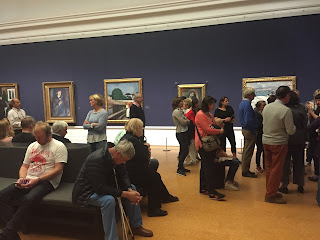Two Deaths
News of the deaths of Michael Graves and Herb McLaughlin reached me on the same day, although McLaughlin died earlier, in February. Their arc (1934-2015) was also similar.
 I met Graves once, at a signing party for the version of The Great Gatsby that he illustrated. I also heard him on a panel with Thom Mayne, during which it was evident that Mayne loathed him. Graves was an elegant man. On the panel, he was ebullient and self-deprecating, making no claims for his work except to note that he liked to draw. (His making no claims seemed to annoy Mayne even more.) Graves had a real hand, as good as Aldo Rossi. Their work had similarities, although Rossi was more astringent. His Theater of the World was to me their point of overlap. Charles Moore, the pop-art Venturi and Scott-Brown, Ettore Sottsass and Memphis, Isozaki, Botta, Jerde - at certain points in their respective careers, they and Graves overlapped.
I met Graves once, at a signing party for the version of The Great Gatsby that he illustrated. I also heard him on a panel with Thom Mayne, during which it was evident that Mayne loathed him. Graves was an elegant man. On the panel, he was ebullient and self-deprecating, making no claims for his work except to note that he liked to draw. (His making no claims seemed to annoy Mayne even more.) Graves had a real hand, as good as Aldo Rossi. Their work had similarities, although Rossi was more astringent. His Theater of the World was to me their point of overlap. Charles Moore, the pop-art Venturi and Scott-Brown, Ettore Sottsass and Memphis, Isozaki, Botta, Jerde - at certain points in their respective careers, they and Graves overlapped.
Graves could be hit or miss. While some of his buildings were outlandish, others were iconic. The objects, especially the Alessi teapot, and the drawings are wonderful. He was a miniaturist who managed to get writ large. That's not always a good thing, but it comes with the territory of "architect."
Herb McLaughlin was an entrepreneur who attracted entrepreneurs in turn; they came and went. His instincts were sound, but his attention span was brief. He constantly reinvented his firm. To me, it never quite added up, but each new incarnation was interesting, a snapshot of the zeitgeist. Born later, he might have been part of the current cohort of new-tech moguls - disruption came quite naturally. Thanks to a mutual friend, I met him socially on two occasions. He too was elegant, and good company. Architects often stake their claims to a larger reputation on their work, but McLaughlin seemed to understand that "being Herb" was sufficient.
 I met Graves once, at a signing party for the version of The Great Gatsby that he illustrated. I also heard him on a panel with Thom Mayne, during which it was evident that Mayne loathed him. Graves was an elegant man. On the panel, he was ebullient and self-deprecating, making no claims for his work except to note that he liked to draw. (His making no claims seemed to annoy Mayne even more.) Graves had a real hand, as good as Aldo Rossi. Their work had similarities, although Rossi was more astringent. His Theater of the World was to me their point of overlap. Charles Moore, the pop-art Venturi and Scott-Brown, Ettore Sottsass and Memphis, Isozaki, Botta, Jerde - at certain points in their respective careers, they and Graves overlapped.
I met Graves once, at a signing party for the version of The Great Gatsby that he illustrated. I also heard him on a panel with Thom Mayne, during which it was evident that Mayne loathed him. Graves was an elegant man. On the panel, he was ebullient and self-deprecating, making no claims for his work except to note that he liked to draw. (His making no claims seemed to annoy Mayne even more.) Graves had a real hand, as good as Aldo Rossi. Their work had similarities, although Rossi was more astringent. His Theater of the World was to me their point of overlap. Charles Moore, the pop-art Venturi and Scott-Brown, Ettore Sottsass and Memphis, Isozaki, Botta, Jerde - at certain points in their respective careers, they and Graves overlapped.Graves could be hit or miss. While some of his buildings were outlandish, others were iconic. The objects, especially the Alessi teapot, and the drawings are wonderful. He was a miniaturist who managed to get writ large. That's not always a good thing, but it comes with the territory of "architect."
Herb McLaughlin was an entrepreneur who attracted entrepreneurs in turn; they came and went. His instincts were sound, but his attention span was brief. He constantly reinvented his firm. To me, it never quite added up, but each new incarnation was interesting, a snapshot of the zeitgeist. Born later, he might have been part of the current cohort of new-tech moguls - disruption came quite naturally. Thanks to a mutual friend, I met him socially on two occasions. He too was elegant, and good company. Architects often stake their claims to a larger reputation on their work, but McLaughlin seemed to understand that "being Herb" was sufficient.





Comments
Post a Comment